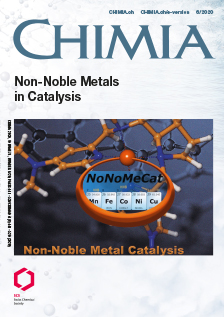Mechanistic Investigations of Nickamine-catalyzed Hydrosilylation of Alkenes: Nickel Nanoparticles Are the Active Species
DOI:
https://doi.org/10.2533/chimia.2020.444PMID:
32560749Keywords:
Hydrosilylation, Mechanism, Nanoparticle, Nickel catalysisAbstract
Hydrosilylation is an important chemical process for the synthesis of organosilanes and for the production of silicone polymers. The wide variety of catalysts developed for this reaction generally follow a Chalk-Harrod, or a sigma-bond metathesis mechanism. Recently, our group developed a nickel pincer complex, Nickamine, for highly selective hydrosilylation of alkenes. Preliminary mechanistic studies had suggested a pathway that deviates from both Chalk-Harrod and sigma-bond metathesis cycles. Here we used in situ NMR to monitor the hydrosilylation reaction. The observed induction period indicated that the species previously believed to be the resting state is merely a precatalyst. Via a combination of Transmission Electron Microscopy, mercury poisoning test, and competition reactions we show that the true catalyst is not a molecular nickel species, but rather nickel nanoparticles.Downloads
Published
2020-06-24
Issue
Section
Scientific Articles
License
Copyright (c) 2020 Marten L. Ploeger, Ivan Buslov, Xile Hu

This work is licensed under a Creative Commons Attribution-NonCommercial 4.0 International License.
How to Cite
[1]
M. L. Ploeger, I. Buslov, X. Hu, Chimia 2020, 74, 444, DOI: 10.2533/chimia.2020.444.







